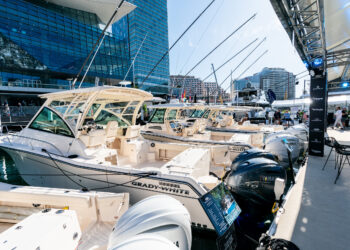I’VE always loved boats and, until recently, considered kayaks a “cheaper” alternative to boat fishing. I’ve owned and fished from kayaks for the past 25 years. Most of my kayak fishing has been done in the smaller creeks, dams and shallow water estuaries; in other words, places I can’t access from a boat. That naturally influenced the type of kayak I owned, which was usually small, lightweight and simple. I shied away from the larger pedal models and opted for an “old school” paddle kayak.
Then I sold my boat (and ordered a new one). Without a boat for a few months I had had withdrawal symptoms. Land based fishing is fun and can be productive, but I needed the freedom to explore more water and keep my options open. The solution was to break out the kayak. Break out was an understatement. I have two kayaks, a Wilderness Systems Tarpon 120 and a smaller Tarpon 100, plus there’s a big Canadian canoe from Old Town. The Tarpon 120 was “buried” alongside the house, covered in spiderwebs, with weeds growing inside. I gave it a clean up and took it to Sydney Harbour.
My mate Hugh met me at Drummoyne with his brand new Hobie Outback. The two kayaks were a perfect example of old vs new and the advancements we’ve seen over the past decade in specialist fishing ‘yaks. We launched and had a great morning chasing Sydney Harbour kingfish. I’ve since taken the old ‘yak to several other areas and enjoyed some productive, yet simple fishing.
So what’s the difference between kayaks? What makes one better than the other?

The obvious question
Paddle or pedal? The topic of pedal vs paddle has been covered extensively in the past, but it’s still worth noting. The concept of pedal powered kayaks, such as the popular Hobie kayaks, is your hands are free for fishing. They’re also much faster than paddle varieties. The only negative I see is most of the pedal type kayaks are quite large and cumbersome. So if fishing small creeks, dragging up shallow rapids, or solo loading onto a hatchback is your thing, perhaps a smaller paddle kayaks is for you.
The paddle kayaks are generally lighter and easier to manage in the above scenarios. That said, many of them don’t have the same dedicated fishing features as the specialist Hobie kayaks. Many also aren’t as stable and are slower moving through the water. Like any boat purchase, it’s compromise.
I personally enjoy using a paddle kayak, but after fishing alongside a high end pedal kayak like the Hobie Outback, I’d be lying if I said I wasn’t envious. The tackle storage, stability, comfy seat and optional extras makes the Hobie, and similar pedal kayaks, a perfect option for the serious ‘yak fisho.

Other options
Most fishing kayaks are “sit-on-tops”. The sit-on-top means, as the name describes, you literally sit on top of the ‘yak. There are scupper holes to drain water and a combination of dry storage under a hatch and wet storage on the deck. They’re probably the best all round option and available in pedal and paddle. The other option is a “sit-in” kayak. This variety is more of a traditional kayak and usually means you have your legs covered and you’re lower to the water. There’s still storage, but it’s at the front and back underneath the decks. The lower position isn’t as great for fishing, but it’s stable, out of the sun, and these kayaks are usually faster to paddle. The sit-in kayak is typically paddle only. It’s worth noting, if water enters a sit-in kayak, its doesn’t drain out. You have to use a sponge or pump if there’s a lot of water. Again, one kayak type isn’t better than the other. I fished out a basic sit-in kayaks for years. It was incredibly light, nimble and stable.
Another option is a canoe. A canoe is typically bigger and open. Just like the sit-in kayak, it doesn’t self drain, so any water that enters the canoe, stays in the canoe. I find it usually enters via the paddle… On that note, the best paddles are single and the steering is usually done from the back of the canoe. The person in the front (of a two person canoe) helps by paddling, not steering.
Canoes hold an incredible amount of gear. My Old Town canoe hold up to 600kg of gear. Even loaded up it remains stable and an excellent fishing platform. I’ve taken it on multi day trips and day trips to rivers and estuaries.
In a nutshell, canoes are for multiple people who wish to carry plenty of fishing and camping gear, while kayaks are for solo fishos and lighter loads.
Hopefully the above helps decide which kayak suits you. And remember, a suitable kayak or canoe doesn’t have to be a poor alternative to a boat.

Kayak Storage in Sydney Harbour
Kayaking is a great way of fishing Sydney Harbour, but not everyone is lucky enough to live somewhere with enough storage to keep a kayak. Others don’t own a car capable of carrying a large Hobie. Thankfully, there is a solution…
Birkenhead Point Marina has come up with a clever kayak storage facility. The facility on the Parramatta River and Iron Cove at Drummoyne conveniently holds your kayak securely and is accessible 24 hours a day. It’s as simple as turning up, unlocking your kayak and using the private launching facility. After you’ve finished fishing, there’s a wash down area for the kayaks and access to the marina’s lounge and shower area. It’s a fantastic idea for simple early morning fishing sessions before work. There’s also a handy kiosk with coffee and snacks available right on the water! You can park, head out for a couple of hours, come back, wash the kayak, wash yourself and be at work by 9am. Too easy!
For more info about Birkenhead Point Marina Storage at birkenheadpointmarina.com.au.
















